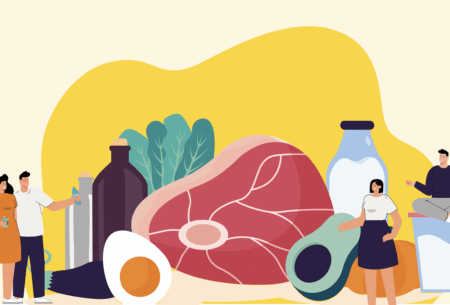Food combining diets claim many benefits, from better digestion and bloating relief, to more energy and better skin. But does it actually work? Read on for the facts…
Spoiler: Ultimately, what we now know about nutrition and digestion contradicts it, so I wouldn’t recommend it. You absolutely can load up your festive feast with all the trimmings (yes, Brussels sprouts too!) on one plate – don’t let ‘food combining’ ideas stop you.
First, what actually is food combining?
This concept is based on an ancient Ayurvedic theory that, as foods are digested at different speeds, only certain foods should be eaten together (which digest at the same speed) and some should only be eaten separately. Otherwise, say hello to digestive issues and even disease due to the food ‘rotting’ in your stomach (spoiler: that is NOT the case – more on that shortly!)
Some of the key ‘rules’ include not eating protein and fat together, only eating fruit alone, and not mixing protein and starch (a type of carbohydrate).
Now, this isn’t to criticise the spiritual practice of Ayurveda, but it’s important to know that a lot of the claims around ‘food combining’ aren’t backed up by science.
So what does the science say?
For starters, there was one clinical trial looking at a ‘food combining’ diet, back in May 2000, and it focused on whether it could impact weight loss.
In short, 54 patients with obesity followed 1,100 calories per day diets, all with similar composition and amounts of macronutrients.
- One half followed a ‘balanced’ diet with each meal mixing food groups
- The other half followed ‘food combining’ rules, not allowing the consumption of fats and carbohydrates at the same time
At the end of the 6-week study, both groups experienced a significant decrease in total body weight and BMI – yet there was no difference between the groups. There was also no significant difference between the two groups in cholesterol levels – indicating there’s no advantage in terms of weight management or heart health to a food combining diet.
What’s more…
Beyond the specific trial looking at food combining, wider modern science simply doesn’t validate this type of eating…
- We don’t just eat nutrients, we eat real, whole foods. And most foods contain a mix of macronutrients (beans, for example, are a good source of protein and carbohydrates), so it’s not really possible to only eat one macronutrient at a time.
- Our bodies are designed to break down and digest different food groups within the same meal, as our digestive enzymes are constantly working together.
- Our stomach is naturally very acidic and much more concentrated than a piece of fruit, so adding fruit alongside other foods is not going to cause stomach problems.
- No food or drink is going to change your body’s pH level, no matter what the food combo – it’s really closely controlled.
- Food moving faster through your digestive system doesn’t mean you absorb more nutrients. Food doesn’t ‘rot’ in your stomach either, regardless of what you’ve eaten it with – instead, your digestive enzymes do a good job of breaking it down into molecules that can be absorbed into our bloodstream.
- In fact, combining carbohydrates with protein and good fat sources can help to balance blood sugar levels and keep you satisfied for longer.
But what about people who’ve said ‘food combining’ has really worked for them – what’s the deal there?
Some people do say they’ve found it helpful for bloating or feeling healthier – but that’s likely just down to making better food choices, enjoying more veggies and plant goodness (that’s one thing the diet does allow without restriction!), eating more mindfully and probably limiting more highly processed foods.
So, while it may make some people feel better in the short-term (for the reasons above, rather than the food combining itself), I’d caution against becoming too fixated on any ‘diet rules’ at the risk of ruining our relationships with food. Don’t forget food is about enjoyment too!
If you’re avoiding fruit or gut-loving resistant starch (found in beans, wholegrains, potatoes and more) – because the food combining diet dictates it’s not the right time to eat them – you could well be missing out on key nutrients and depriving your gut microbes of their favourite foods. And we do NOT want hangry microbes!
The one area food pairing is a good idea… 100% plant-based diets.
If you’re following a vegan diet, there are certain nutrients that can be a little trickier to get. That’s where food pairing can come in handy, as some foods contain certain chemicals that can improve the absorption of chemicals in other foods.
Adding vitamin C, for example, while eating a plant-based iron source (non-haem iron) improves our ability to absorb it. So try using a tomato base, rich in vitamin C, when cooking with lentils, or having some strawberries with a handful of nuts and seeds.
Read more on the key nutrients to consider for a vegan diet here.













